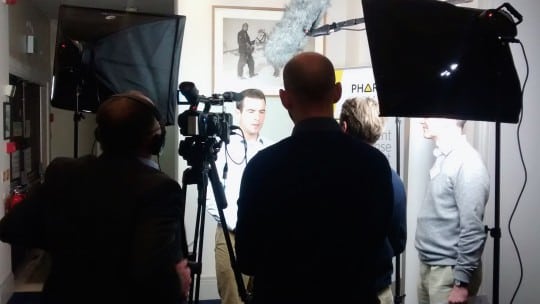
In our nervous-twitch environment, PR execs who provide media training often face an executive or a team that has received coaching previously. These executives or team members know—or think they know—the basics and don’t want to waste time on Training 101. They are content-and results-focused and likely lack the PR knowledge about how the 3 P’s (preparation, practice and performance) can be the difference between a successful or unsuccessful interview.
How should communicators react? I’m a fan of trilogies, so here are three things an expert media trainer needs to be able to do:
1. Know the Content and Challenging Questions.Formulaic media training no longer cuts it. Counseling top executives to “Know your three messages. It doesn’t matter what they ask, just score your messages even if you aren’t really answering the questions” might fail to provide added value.

Sure, that tactic might work with reporters who don’t listen or lack a deep understanding of the subject. And of course if your executive is taping B-roll or is asked “Is there something else you would like to add?” and/or “Is there something I forgot to ask you?” those are perfect opportunities to score.
The trainer can no longer teach the executive to score them no matter what the question. That’s where the subtleties of the “Bridging/Pivoting” technique come into play (see below). Credibility is lost when pivots are blatant. Want proof? Watch a cringe-worthy interview on MSNBC, Fox or CNN and you’ll see what it’s like for a business professional to walk into a major interview unprepared—and pay the price.
[Editor’s Note: Subscribers can see Gilman’s examples of good and bad interviews, as well as other media training resources, at the PR Pro Essentials page]
For the trainer, this requires detailed research. Start by digging into material about the subject(s) of the interview. Do the journalistic homework and find and read analyst reports about the executive’s part of the business, negative articles, and what’s been written about the competition. After that read up on the journalist, including his or her website, and determine the journalist’s FAQs.
2. Know the Executive’s Background and Personality.Remember the Stephen Colbert line: “It’s bigger than you and me, it’s all about me.” In the case of media training a senior leader, it’s often all about the executive.
Get a bio, LinkedIn profile and, perhaps most important, find articles about and video examples of the executive. Should you be preparing the executive for an interview with a particular journalist it behooves you to bone up on the journalist, too, as mentioned above.
This preparation is the equivalent of the physician who studies a patient’s chart before conducting an exam. It’s one thing to know a patient’s condition, but rapport, diagnosis and treatment work better when you get under the hood.
3. Be Flexible and Use the Executive’s Experience. Long gone are the days of a full-day media training session with three or four participants who learn the fundamentals and practice with two or three interviews, picking up pointers from colleagues and applying them.
Everyone wants training in a compressed timeframe and promises that he or she will practice more on their own or with other members of the PR team.
A skilled trainer enters each session ready to adjust from the pre-session plan. You might start with message review and go to a practice interview. In another session, conduct the mock interview first and while reviewing the video make “surgical-strike” comments on how to craft the message and apply technique. In one session, you get the team to work and review together. During another session the trainer conducts an overview with the group, then schedules one-on-one sessions with executives and spokespersons. As I noted above, make use of the execs’ experience.
This reminds me of a senior executive who challenged me to provide value-added to his communications objectives. In fewer than 10 minutes, I demonstrated how to take his current messages and add a “story” element so that they would have more impact on key audiences. I then quickly showed him how a mind map could help him weave his messages into any key Q&A session. After hearing about these modules, he was willing to practice and watch himself.
Question: When is the best time to communicate a message during an interview? Answer: Whenever you can. There are three easy places to insert messages. At the start, during the interview and on the last question:
At the start, frame the subject. I know an executive who is very assertive when he starts an interview. First, he prepares. Once he gets to the interview he tells the reporter: “I know you have many questions for me. If you want to ask, go ahead. However, I just came back from a customer presentation that is close to the topic you want to discuss. We spent 45 minutes on two slides. If you want, I’ll email you those slides. Ask me questions about this presentation and at the end if you have other questions, please ask them.” This executive says 80% of reporters comply.
Pivoting. Answer the question and then use bridging phrases. No one phrase will work every time. Have several ready: “But” and “however” are classics. Other phrases, depending on the question, include, “Actually, that’s not the data we have seen,” or “I can’t answer the first part of your question since I’m not our best expert on that subject, but here’s what I can say,” or “I can’t answer that because of HIPAA or employee confidentiality rules, but for that kind of information, I can refer you to____,” and “What I can say? I’m sure our competitors would love to know that information as well, here’s what I can share….”
At the end of an interview. Most good reporters will close with “Is there anything else you want to share?” or “Is there something I forgot to ask you?” Reporters usually want your best information. They also know they aren’t perfect, so these questions give you a chance to score a message. Some reporters either are in too much of a rush or don’t want to betray a lack of knowledge about you and your business, so they won’t ask these traditional ending questions. Be ready for this and make sure you close the interview by saying, “Let me wrap up with one or two points.”
CONTACT: [email protected]
